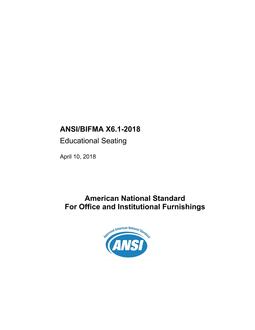
Click here to purchase
BIFMA X6.1-2018 is intended to provide manufacturers, specifiers, and users with a common basis for evaluating the safety, durability, and structural adequacy of Educational Seating, including units with integrated desk or table surfaces. The tests in this standard are intended to evaluate seating for students in pre-school, elementary, middle school, high school, adult education, trade school, and college environments. These tests are not intended to evaluate products used in living/dorm environments. The educational seating products covered by this standard are normally used in schools and colleges and include those typically referred to as chairs, stacking chairs, tablet-arm chairs, chair-desks, stools, and convertible bench/tables. Seating products that are anchored to the building floor or structure and bleachers are not specifically addressed in this standard.
Chairs with tilting seats and/or backs such as executive/management chairs, task/secretarial/teacher chairs, side/guest chairs may be used in educational environments, but these products are covered by ANSI/BIFMA X5.1 General-Purpose Office Chairs – Tests (designated within that standard as Type l and ll). Similarly, items such as lounge seating may also be used in the educational environment; however, these are covered by ANSI/BIFMA X5.4 Lounge Seating – Tests. Mobile cafeteria tables with attached seating are covered by UL 2040 “Folding Rollaway Tables”. Where a product may be covered by more than one ANSI/BIFMA standard, the manufacturer shall determine which standard provides most appropriate test conditions. Where a product is intended for use outside of the educational and related institutional environments, it is the responsibility of the user of this standard to determine if it is suitable for use in such evaluations.
Tests in this standard were developed considering the weight ranges based on age (not grade level) for the size categories. These weights were taken from CAESAR and/or NHANES as appropriate. Where appropriate, the National Health and Nutrition Examination Survey (NHANES) 2011-2014 study was used in the development of the tests (see Table 2). This standard also considered the occasional use of the smaller (Category A and B) products by adults. The tests were developed with an estimated product life of ten years based on estimates for usage as determined by the manufacturers’ experience and research.
In general, seating was estimated to be used 6.5 to 8 hours/day and 170-180 days per year for learning environments and other common space environments and 2 to 4 hours/day for convertible bench tables. Product life will be affected by user size/weight, daily hours of use, product use, care and maintenance, environment, and other factors, and, as such, product compliance to this standard does not necessarily guarantee a ten-year product life. Actual life of the product may be more or less than ten years depending on the aforementioned factors.
This standard describes the means of evaluating Educational Seating, independent of construction materials, manufacturing processes, mechanical designs or aesthetic designs. This standard does not address flammability, surface material durability, cushioning materials, product emissions, lead content, or ergonomic considerations; these properties may be covered by other standards/regulatory documents.
The standard defines specific tests, the laboratory equipment that may be used, the conditions of tests, and the minimum acceptance levels to be used in evaluating educational seating. The acceptance levels given in this standard are based on the actual field use and test experience of BIFMA International members.
The tests in this standard are intended to assess the performance of new products only. They are not intended to assess a product that has been in use.
ISO 17025 requirements for measurement uncertainty do not apply to this standard.
Product Details
- Published:
- 04/10/2018
- ANSI:
- ANSI Approved
- Number of Pages:
- 106
- File Size:
- 1 file , 1.9 MB
- Redline File Size:
- 2 files , 7.6 MB